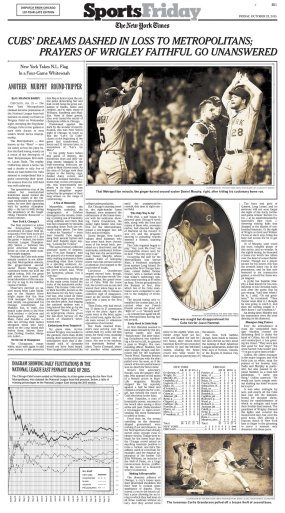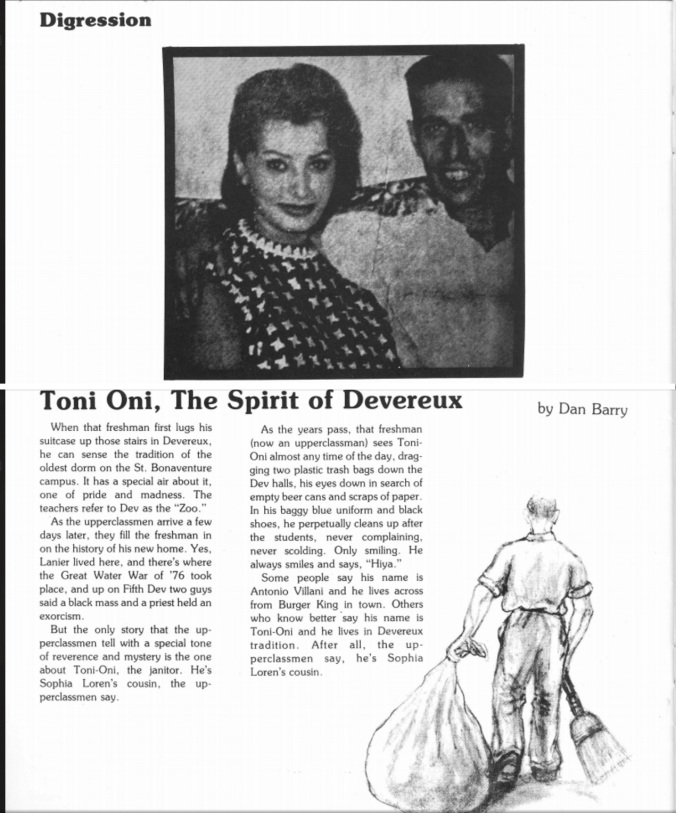Perhaps Dan Barry is the best person to describe his own career exploits, from an excerpt of the commencement address he delivered at his alma mater St. Bonaventure University just weeks ago:
“I’ve been a newspaper journalist for 35 years and I have written thousands of stories. Small town crimes and big city massacres. Political campaigns for Town Council and for the United States Senate. Saints and mobsters. Burlesque queens and circus elephants. The powerful and the powerless. I have met the coroner from The Wizard of Oz. I have witnessed a man’s execution. I saw New Orleans underwater after Hurricane Katrina. I spent an entire year writing about what happened to the city of my birth after an attack on a sunny Tuesday morning in September. In some ways, I’m still writing about that.”
Dan Barry is truly one of the great storytellers of our time, best known as the columnist for the regular New York Times feature “This Land,” which tells the tales of ordinary people with unique stories or meaningful lives in the hidden corners of America. It’s always a refreshing break to read that in a newspaper often noted for its coverage of the most powerful, from presidents to popes to dictators. Among Barry’s best writings include:
- The tale of Mamie Lang Kirkland, the elderly black woman who finally returned to her home state a full century after her family left while fleeing a lynch mob.
- The offbeat story of activists in Keene, New Hampshire who were paying literally all the parking meters in the town to “save you from the king’s tariff.”
- The sad life of Jesse Webster, who since 1996 has served life in prison without parole for a completely nonviolent offense.
-

Dan Barry’s 1908-style baseball column in the NYT print edition. Click for a larger view. (It should surprise nobody that the Cubs lost.)
His column last October covering a Chicago Cubs vs. New York Mets baseball game as though it was 1908, featuring old-fashioned terminology (a single becomes a “one-bagger” and the Mets become “the Metropolitans”), a century-old font in the newspaper print edition, and grainy black-and-white photographs.
- Another baseball-related story, his book “Bottom of the 33rd” about the longest baseball game of all time in 1981. Barry alternates chapters describing the game inning-by-inning and tracking down the (often tragic) lives of the minor-league players in the subsequent three decades. I read the whole thing, all 33 innings of it, and I’d highly recommend even if you don’t love baseball. As proof, I don’t love baseball!
- Barry’s new book, released just last month, is “The Boys in the Bunkhouse: Servitude and Salvation in the Heartland,” the true story of several dozen intellectually disabled men who were kept in servitude for more than 30 years in a small Iowa town without anybody knowing before gaining their freedom.
The piece Barry submitted for A Step in the Write Direction is a short column he wrote for his college publication the Bonaventure Convex in December 1978, about a janitor at a university dorm building who had more to his life than met the eye. The piece shows early glimpses of the “aura of mystique” writing style that Barry uses so often today, in particular phrases like “some people still say…” Below is Barry writing about what he remembers about writing the piece, followed by a photo of the piece as it appeared in the print edition you can read, followed by the original text copied and pasted. (A note for younger readers: Sophia Loren, who is mentioned more than once in the column and featured in the photo accompanying the piece, was an Oscar-winning actress from the ’50s and ’60s.)
Check out Dan Barry at his official website DanBarryOnline.com, follow him on Twitter at @DanBarryNYT, on Facebook at DanBarry.Author.
The story of Tony Oni — whose real name was Tony Villani — had a deep impact on me. I was a student at St. Bonaventure University, trying to imagine a life as a journalist who told the stories of others, including the vulnerable. And here, every morning, came Tony to my dormitory to pick up the beer cups and other debris of a bunch of relatively privileged young men from Syracuse and Buffalo and Long Island. Some ridiculed him for his intellectual disability, even as he cleaned their mess.To check out the rumor that he was Sophia Loren’s cousin, I visited Tony in his squalid apartment in a dodgy part of town. He said he had a photo; it turned out to be a movie poster on his wall. But I kept digging, and ultimately found a photo of the two of them in an old campus newspaper.I’m indebted to Tony Villani. I learned about the chasm that existed between the non-disabled and disabled worlds — that still exists, as I recently discovered in researching and writing “The Boys in the Bunkhouse.” I learned about not giving up in digging for facts. And I learned the rush from snatching a true story from out of the clouds of myth and rumor.

Toni Oni, The Spirit of Devereux
By Dan Barry
When that freshman first lugs his suitcase up those stairs in Devereux, he can sense the tradition of the oldest dorm on the St. Bonaventure campus. It has a special air about it, one of pride and madness. The teachers refer to Dev as the “Zoo.”
As the upperclassmen arrive a few days later, they fill the freshman in on the history of his new home. Yes, Lanier lived here, and there’s where the Great Water War of ‘76 took place, and up on Fifth Dev two guys said a black mass and a priest held an exorcism.
But the only story that the upperclassmen tell with a special tone of reverence and mystery is the one about Toni-Oni, the janitor. He’s Sophia Loren’s cousin, the upperclassmen say.
As the years pass, that freshman (now an upperclassman) sees Toni-Oni almost any time of the day, dragging two plastic trash bags down the Dev halls, his eyes down in search of empty beer cans and scraps of paper. In his baggy blue uniform and black shoes, he perpetually cleans up after the students, never complaining, never scolding. Only smiling. He always smiles and says, “Hiya.”
Some people say his name is Antonio Villani and he lives across from Burger King in town. Others who know better say his name is Toni-Oni and he lives in Devereux tradition. After all, the upperclassmen say, he’s Sophia Loren’s cousin.

& when our 1st son was born named for his father he looked down at our tiny baby & said Tony Oney. So happy to read Dan’s story 55 years later!!
LikeLike
Nicely done Dan. Mary Helen Hummell (Collins) 4th Loughlin girl. You’ve done well – congratulations.
LikeLike
TO DAN BARRY; YES IT’ ALL TRUE TONY WAS SOPHIA LOREN’S COUSIN. HE LIVED ACROSS THE STREET FROM ME ON NORTH 5TH STREET, OLEAN, NY IN AN APARTMENT OWNED BY THE RUCINSKI FAMILY. HE RODE A BIKE TO WORK WITH RACCOON TAILS ON THE HANDLE BARS. SOPHIA BOUGHT HIM A NEW BIKE EVEY YEAR AND HE WOULD VIST HER IN SCRANTON, PA FROM TIME TO TIME.
LikeLike